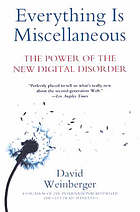Classification and categories
Watch this and consider how the Library of Congress classification system operates

Readings
Read pages 237-275, Classification: Assigning Resources to Categories. by Robert J. Glushko, Jess Hemerly, Vivien Petras, Michael Manoochehri, and Longhao Wang, in Robert J. Glushko's The Discipline of Organizing, MIT Press, 2013.
Pay particular attention the section on p. 237, 7.1.2 Classification vs. Tagging. Think about how this text considers social classification and folksonomies with how the next reading considers them.

Read chapter 3, The geography of knowledge, pages 46-63 in
Weinberger, D. (2007).
Everything is miscellaneous: The power of the new digital disorder.
New York: Times Books.
The book's blog doesn't say this, but:
charts how as business, politics, science, and media move online, the rules of the physical world - in which everything has a place—are upended. In the digital world, everything has its places, with transformative effects:
- Information is now a social asset and should be made public, for anyone to link, organize, and make more valuable.
- There's no such thing as "too much" information. More information gives people the hooks to find what they need.
- Messiness is a digital virtue, leading to new ideas, efficiency, and social knowledge.
- Authorities are less important than buddies. Rather than relying on businesses or reviews for product information, customers trust people like themselves.
Compare Weinberger's discussion of collaborative filtering on pages 60-63 with Glushko's treatment of social classification.
- Which one holds more resonance for you?
- Which viewpoint seems to relate more to the world you inhabit?
Continue to think about how you organize your information worlds
[top]


